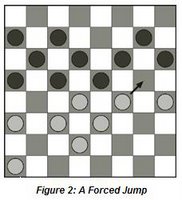Backgammon (11)
How to Play Backgammon
Sending Blots to the Bar
A single stone resting on a point is a target. It's called a blot, and when you land directly on an enemy blot it's called a hit. The blot is then retired to the bar. The blot must be entered and become a stone again before you can move any of your other pieces. Plus, the lonely blot must enter the enemy's home table on an open point. For example, if you roll a 5-2, and if points 5 and 2 in the enemy's home table are open, you can choose either one and place your blot there. If you placed it on point 5, you can now move it two points.
If one of those points is occupied by a single stone of the enemy's, you can hit it and send it to the bar. If none of the points are open, if your enemy's stones have crowded all available space, you are shut out and you don't even get to throw the dice. Your blot remains on the bar and you can't move any other. Your turn is over.



When you've collected all of your stones in your home table, you can bear off: that is, remove all your stones from the game, in the order determined by the dice. If the number you rolled is higher than the number of points you have yet to travel, you simply bear off the piece that's farthest away.
If you're hit after you've started to bear off, your stone becomes a blot on the bar. You must enter it and bring it around to your home table before you can go back to bearing off.
Next: Gammon and Backgammon

























